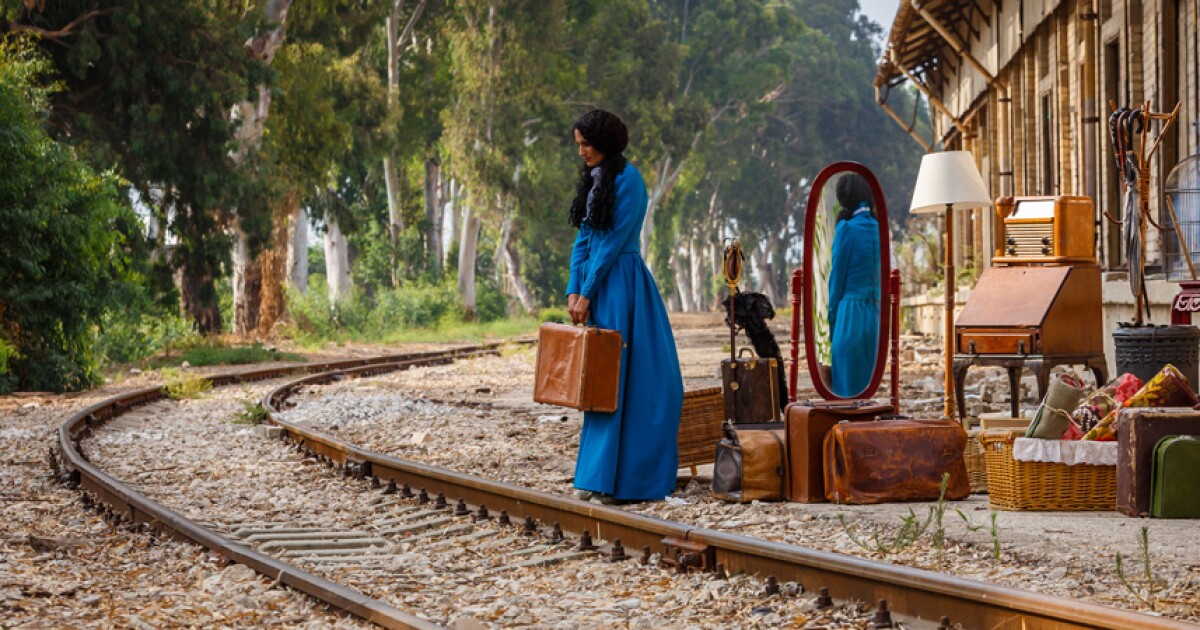American culture is infused with the work of artists who come to the U.S. from around the world.
“Artists, Born Elsewhere” at the University Museum of Contemporary Art in Amherst, Massachusetts, highlights that idea as a theme.
For the exhibit, which runs through December 10, a portion of the small museum was temporarily rebuilt into a screening room, basically a giant box with benches to sit on.
“Strangeness,” a 33-minute film by Palestinian Israeli artist and actress Raida Adon, runs on a loop. It came to the museum after Adon’s first solo show in 2022 at the Rose Art Museum at Brandeis University in Waltham.
There’s no dialogue in the film. In the opening scene, a Romanian lullaby guides well-dressed women, men and children walking through a forest with suitcases. They’re not from anywhere identifiable, though they’re definitely leaving somewhere.
Adon made “Strangeness” in 2018, though her work is timely as she depicts the experience of displaced people from around the world. Adon explained in a recent video conversation — which NEPM was not allowed to record — how the characters in her film play out our shared fears: war, death, becoming refugees.
It’s visually beautiful and moving, and a bit disturbing, like “Alice in Wonderland,” said University Museum of Contemporary Art Interim Director Amanda Herman.
“Throughout the film, [Adon] plays with scale,” Herman said. “So she’s either too small or too large for her surroundings, always out of place, trying to find her place within the landscape.”
The film’s ethereal soundtrack fills much of the small museum and it was a starting point for the overall 30-piece exhibit “Artists, Born Elsewhere,” initially conceived of by Loretta Yarlow, the museum’s longtime director who retired earlier this year.
The show was an opportunity, Herman said, to look at immigration and displacement through art instead of the news. Some of the works are abstract, including one from New York-based artist Julie Mehretu, originally from Ethiopia.

Courtesy
/
University Museum of Contemporary Art
“This is an etching and it’s just it’s very beautiful,” Herman said, standing by Mehretu’s “Fracture,” made in 2007. “If you look closely, there’s layers and layers of marks, and I think it looks like when you see a group of birds exploding out of a tree into an evening sky.”
Some pieces connect directly to the idea of leaving a place, and re-establishing life somewhere new — like the image “San Francisco” from photographer Robert Frank, born in Switzerland. It’s of a Black man and a Black woman reclining on a grassy hillside with a view of San Francisco before them, turning toward the photographer.
There’s so much value, Herman said, seeing a place through the eyes of a perceived outsider.
“His photographs, especially … in the ’50s leading into the ’60s … I think he was very shocked at that point to see how segregated we were as a country,” Herman said.
Among the featured western Massachusetts artists is Procheta Mukherjee Olson, originally from India, now living in Amherst. Two of her works in the exhibit, like others in the show, are in the museum’s permanent collection.
On a recent evening, she stood by one of her intricate pen and ink drawings, “Quiet in the Afternoons,” from 2015. At first glance, it appears to be a scene of children playing in a living room. They’re on the floor, surrounded by books and plants and a cat. Look closer and the narrative gets dark.
Courtesy
/
University Museum of Contemporary Art
“A cat playing with a severed breast,” Mukherjee Olson said, “and there are two children in the front, and the girl is playing with a severed head. The boy is playing with the entrails of that head.”
Mukherjee Olson said — thematically — her pieces depict a sense of being out of place, but not political displacement. Her art is personal, she said. It’s about moving away from India.
The idea of “home” is something she and others local artists spoke about at a conversation pegged to the exhibit.
The Holyoke-based painter Imo Imeh was part of the panel discussion. Imeh’s parents came to the U.S. from Nigeria, he explained. And when making art, he considers how his origins influence him — when they’re not fully his.
“You know, I can go to my grandfather’s compound and eat a mango from his tree there in Nigeria, but I don’t speak the language,” Imeh said.
Mukherjee Olson feels a similar tension, she acknowledged. You can go down a rabbit hole thinking about the significance of what it means to be an artist, born elsewhere, she said.
“Since I’ve come to the U.S., I’ve definitely seen that — words like ‘American, born Switzerland’ … ‘American, born Latvia’ … ‘American, born India,’” she said.
For artists, there’s more nuance than these labels. But thinking like a curator, she said, the show’s title makes sense. It highlights how American culture is complicated and made up of so many cultures — from around the world.
Disclosure: The UMass Fine Arts Center is a financial supporter of NEPM. Funding relationships do not influence our news coverage.

